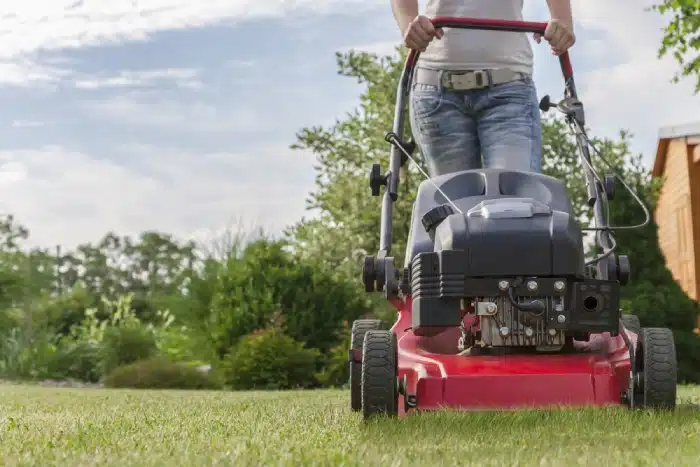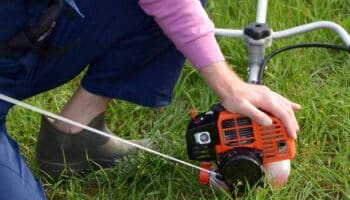We've independently reviewed this article to make sure it's as accurate as we can make it.
To find out more about our article creation and review process, check out our editorial guidelines.
Feeling confused about the differences between FWD vs RWD lawn mowers?
Whether you want to replace your current self-propelled model, or you’re a first-time buyer, making the right choice is crucial, as it can impact the health and beauty of your yard.
Luckily, you’ve come to the right place for answers!
Choosing between FWD vs RDW lawn mowers depends on your needs. Front-wheel drive lawn mowers are more affordable, easy to maneuver, and great for flat lawns. For uneven/sloping surfaces or better traction, rear-wheel drive lawnmowers are recommended.
Keep reading to learn more about their differences!
Front Wheel Drive vs Rear Wheel Drive Lawn Mower
To help you make an informed decision, in this section, we’ll explore the 3 main differences between FWD vs RWD lawn mowers.
#1 Cost
The first, and perhaps the most obvious difference is cost.
A front-wheel-drive mower usually costs less than a rear-wheel-drive version. This is mainly because rear-wheel self-propelled mowers are more complicated and cost more to build.
These days, the cost isn’t as pronounced as it once was because there are a lot more rear-wheel drive mowers available. But as a general rule, front-wheel drive mowers are cheaper.
#2 Maneuverability
While both types of mowers are relatively easy to maneuver, a front-wheel drive version is easier.
The best way to maneuver a front-wheel drive mower is to push down on the handle until you raise the front wheels off the ground. You can then swing the mower around wherever you like and turn it almost within its own radius.
This maneuverability means it’s easier to move your mower around obstacles, plant pots, uneven edges, or your collection of garden gnomes.
One other advantage of the front-wheel drive versions is that it’s easier to move them backward. By lifting the front wheels up, you can easily drag your mower backward without stopping or disengaging the drive. Something you would have to do to pull a rear wheel version backward.
A rear-wheel drive mower doesn’t have straight-up maneuverability, but it does have a couple of other advantages while mowing. The first is that most rear-wheel versions have a variable speed control. This means you can set the velocity to match your own comfortable walking pace and optimal grass-cutting speed.
The other advantage is that some come with the ability to disengage the blades without turning off the motor. This makes it easier to move, pause, and remove an obstacle without stopping the mower. Saving time and extending the life of your mower engine.
#3 Rugged terrain and traction
When it comes to lawns with challenges, usually a rear-wheeled version will deal with them better than a front-wheel version. A lawn on a slope, or with a lot of little bumps and hillocks is better served with a rear-wheel drive.

The reason for this is that you will normally get better traction with a rear-wheel drive mower. On an uneven surface, a front wheel drive mower will often struggle for grip. Making your mowing considerably harder than it needs to be. You have to push and wrestle your mower around a lot more.
Another consideration is the weight distribution. If you are bagging your cuttings, as the weight of the bag increases, so does the weight on your rear wheels. While this increases traction for a rear wheel drive, it will decrease traction for a front wheel drive. You may find the front wheels spinning more as you fill up the bag.
On a lawn with a slope, these considerations are amplified. So, if you have an uneven lawn on a hill, definitely consider a rear-wheel drive. Or even better an all-wheel drive.
A Note on All-Wheel Drive Mowers
Since I mentioned all-wheel drive mowers, I’d like to add some quick information about them. Just like a 4-wheel drive car is necessary for going cross-country, a 4 or all-wheel drive mower is the best option for seriously rugged and uneven lawn terrain.
With the power to all four wheels, it gives an unrivaled grip for challenging lawns. But the advantages come with a cost premium. An all-wheel drive costs more than the other options. So, if your lawn is flat and even, it’s probably not necessary with an all-wheel option. But if you have a steep slope or bumps and hillocks, the extra cost might well be worth it.
What Does Self-Propelled Mean?
Surely you have read the term “self-propelled in this article. If you’re wondering what it means, keep reading.
On a push-type mower, the engine (or motor if it’s electric) drives the mower blades, and that’s it. The blade design and rotational speed give the mower an upward force in much the same way a helicopter works.
This helps you push your mower along by taking some of the weight and effectively making your mower lighter. This is why it’s still easier to maneuver a push mower when it’s working than when it’s turned off. But, you’re still doing the work of moving the mower and the engine does not assist the wheels.

With a self-propelled mower, the engine channels some of the power to the wheels (front, back, or both). This drives the wheels in a similar fashion to a car. With a self-propelled version, there is usually a bar on the handle. Depressing this bar engages the wheels and your mower engine drives them forward, so you don’t have to push.
The difference between front and rear wheel drive is simply which set of wheels the engine is powering.
5 Common Self-Propelling Issues
Now that we’ve established the pros and cons of front vs rear wheel drive mowers, let’s take a quick look at some of the most common problems that cause a self-propelled mower to stop self-propelling:
- Dirt & debris – Keep the wheels and underside of your mower clean. Regular cleaning will stop the buildup of debris that can cause issues such as a skipping drive belt, worn drive wheel assemblies, and extra strain on the transmission.
- Drive wheel assemblies – After a period of use, the drive wheel gear can wear down. It will then slip and stop the wheels from turning. Replacing the gear will solve the problem.
- Drive belt – Eventually, every drive belt will wear, become brittle and fail. Check your drive belt for signs of wear that might be causing it to slip, and brittleness that will indicate it needs to be replaced.
- Drive Cable – If the drive cable is loose, the end connectors stretched, or if the cable is not moving smoothly, it may not engage the drive and your mower won’t move. Inspect the cable from top to bottom and look for signs of rust, wear, or damage. Replace if necessary.
- Transmission – If you tried all the above and still can’t find the fault, it may be there is a problem with your transmission. Depending on your model, you might be able to disassemble the transmission to check and replace parts, or you may need to buy a complete transmission replacement.
Conclusion
That’s our rundown on front vs rear wheel drive mowers. Now you know what self-propelled actually means and the difference between front and rear wheel drive versions.
If you have a good flat lawn, then a front wheel drive will probably be best. It’s cheaper and more maneuverable.
But if you have an uneven surface, a lawn on a slope, or are worried about traction, then a rear wheel drive mower could be the better choice.
Just remember, both versions of self-propelled mowers are useful and make your mowing a pleasure. Good luck with your choice and have fun!







